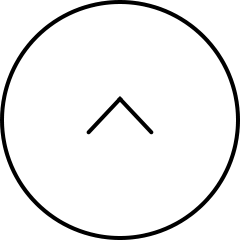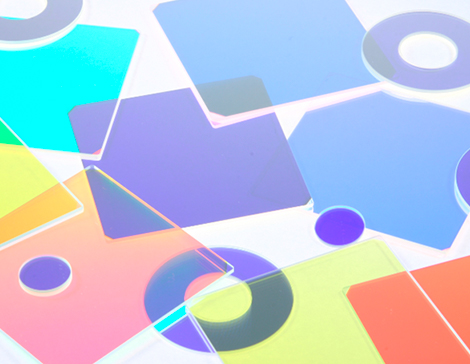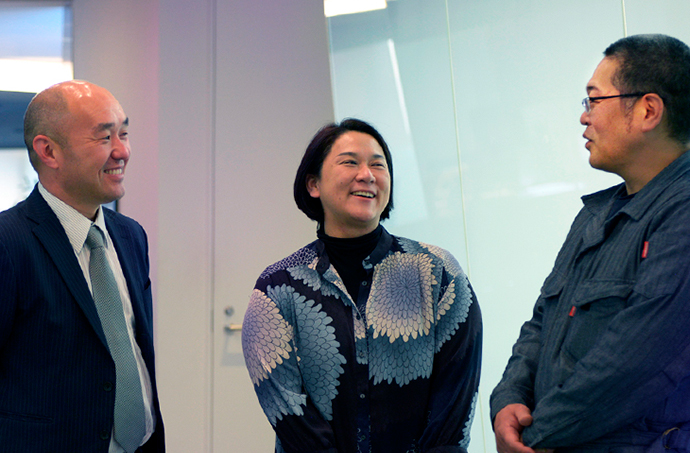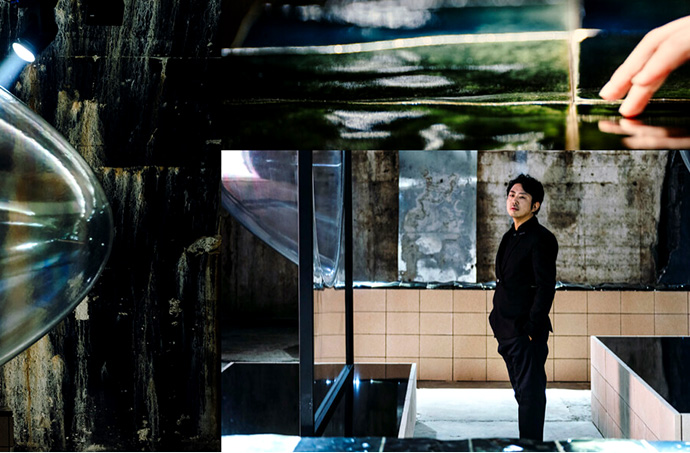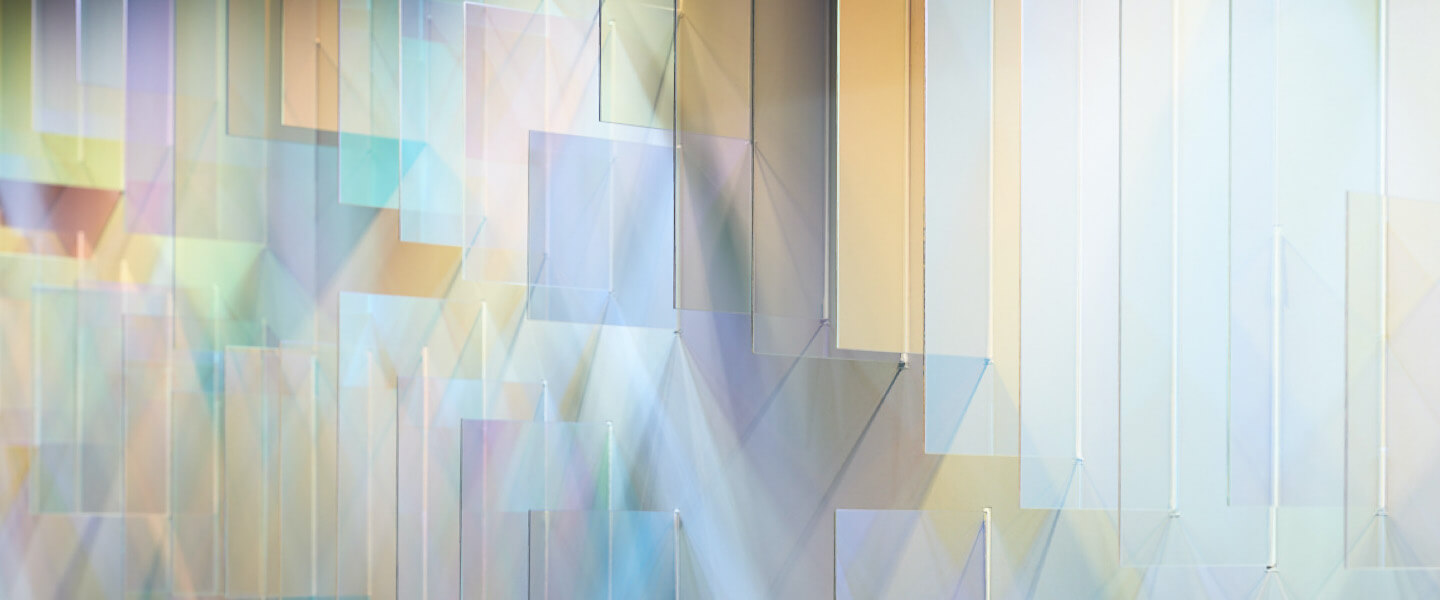
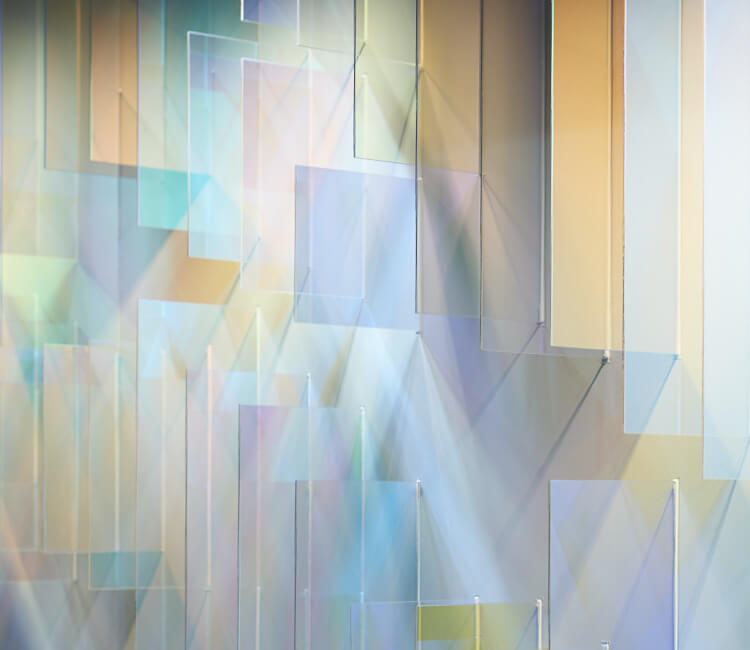
A Sculpture of Light and Color Born from Optical Filters
- #Collaboration
- #Design
Profile

Nobuhiro Nakanishi
Sculptor
Born in Fukuoka in 1976. Graduated from the Department of Fine Arts (sculpture major) of Tokyo Zokei University in 1999 and from the Department of Sculpture, Graduate School of Arts, Kyoto City University of Arts in 2002. Currently lives in Osaka Prefecture. He has had many exhibitions in Japan and Europe and, recently, in the Middle East. Main solo exhibitions include Saturation at the Osaka Prefectural Contemporary Art Centre (2006), transparent view at Aomori Contemporary Art Centre (2011), Roppongi Crossing 2007: Pulse for the Future at the Mori Art Museum (2007), and Islamic Arts Festival 19th Session -"Bunyan" at the Sharjah Art Museum, UAE (2016-17) Majored in sculpture and, based on his sculptural experiences, he realized that sculpting the human body and objects was not merely an act of sculpting something concrete or “positive,” but there is also a “negative” element that surrounds it. In other words, by expanding his consciousness to include the entire space, he has been able to capture his subjects from both poles, the positive and the negatives, the tangible and the intangible, the visible and the invisible, and visualized them. His major works include the Layer Drawing series that turns space and time into sculptures and his freehand Stripe Drawing series, which are created by lines and the spaces between them, both of which he has been working on simultaneously since the early 2000s.
A new must-see spot has arrived in Kyobashi Station in Tokyo, Japan. “Stripe Drawing – Flow of time” is a public art installation created by sculptor, Nobuhiro Nakanishi. This artwork, which is located inside the Kyobashi station on the Tokyo Metro Ginza Line, is created with dichroic mirrors, which are optical filters that can control light with nanometer wavelengths. When a precision industrial product encounters an artist who treasures emotion above all else, what kind of chemical reaction will occur? And what will be born from that encounter? “Flow of time” is one answer to these questions. Anyone who stands in front of this artwork could not help but sigh to witness this “happy meeting” between two parties that ordinarily would not intersect.
Before the work was opened to the general public, we spoke to Nakanishi, along with Tomonori Enyo of Optical Coatings Japan (OCJ), the manufacturer of dichroic mirrors, about some of the things that happened during its production and the passion that has been imbued in the artwork.
(Note: The talk was held in February 2020, before the installation was completed.)
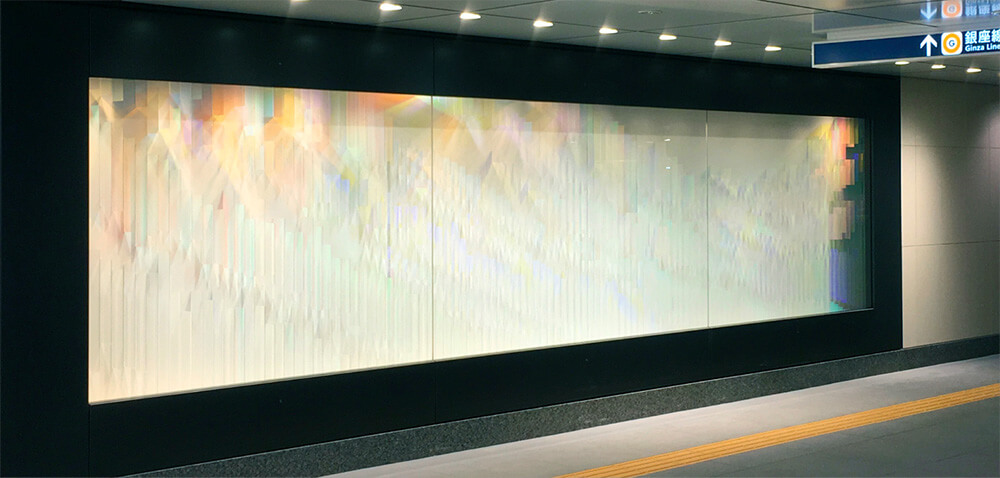
Public artwork installed in Kyobashi. It contains about 600 sheets of glass.

Nobuhiro Nakanishi, designer of the artwork
Nobuhiro Nakanishi (Nakanishi) When this project started, AGC showed me samples of several different materials, and I was immediately drawn to the dichroic mirror. I have created several pieces using mirrors and glass in the past, but I have never before seen glass that changed color depending on the angle at which light is cast on it and position of the viewer. With this material, I thought I could express the transition of time by changing the colors by season and time of day. With that thought, I decided to take on the challenge of creating a work of art with this unknown material.
Tomonori Enyo (Enyo) Dichroic mirror is an optical product in which the thin film coating on the glass cuts off or lets through light of certain specific wavelengths. OCJ started mass-production of this product around the mid-1950s to mid-1960s. This was around the time that color TV started broadcasting in Japan. At the time, this product was used as parts in color televisions and it underpinned the popularization of color TV in the country, albeit behind-the-scenes.
More recently, it has been used in a variety of fields, including liquid crystal projectors, but it is a product that is hardly ever seen by the general public. The product itself is very beautiful, so I have been wondering for a long time if there was a way it could be used in situations where it would be more visible, such as in accessories.
So, when I learned that Mr. Nakanishi was going to use it in his artwork, I was so excited, I punched the air in my heart, thinking, “Yes! Finally!” (laughs) The other staff at OCJ are also delighted and they can’t wait to see the artwork once it is completed.
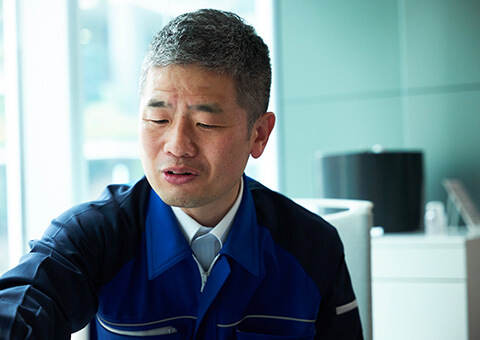
Tomonori Enyo of Optical Coatings Japan
Dichroic mirror is an optical product in which coated glass either passes or reflects light at specific wavelengths. It can adjust the wavelengths of light’s three primary colors, separate its elements, and adjust its path.
Dichroic mirrors are used as color filters in imaging fields such as liquid crystal projectors, as well as in fluorescent microscopes and analysis equipment, by increasing color separation precision.
Optical Coatings Japan, an AGC Group company, started to develop dichroic mirrors in 1957, and began mass-producing them in 1963.
Optical Coatings Japan website:https://www.ocj.co.jp/
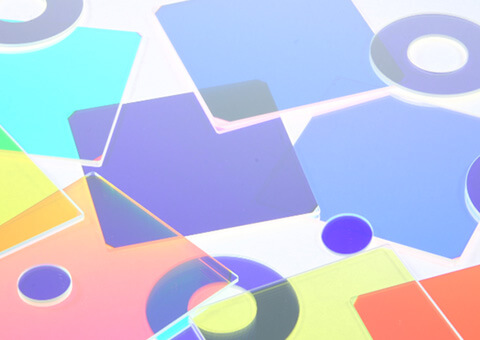
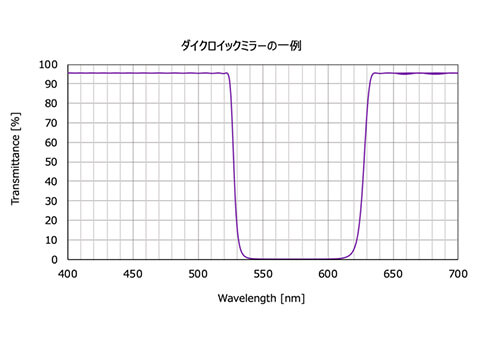
This project began with the melding of Nakanishi’s and Enyo’s shared passion for the product, but initially, they found themselves talking at cross purposes and struggled greatly to reach common ground. This was due to the huge gap between their respective recognitions of “color.”
Nakanishi I am interested in using new materials in my work, so I was very much looking forward to making an installation with this new material. However, as our conversation progressed, I started to get the feeling that it was a much more difficult undertaking than I thought, and concerns were starting to be raised in my mind. This is because, until then, I had always thought of color as something that had substance, like picking out a certain color paint at the art supply store. Even if the store did not have the color I wanted, if they had a color chart, I could choose from that. Dichroic mirror, on the other hand, is a functional product that controls light based on wavelengths. Because our definition of color was different, I did not know how to explain the colors I wanted. In other words, we realized that we did not have a common language to communicate with each other. So, in my early conversations with Mr. Enyo, I felt as if I was talking to someone from outer space (laughs).
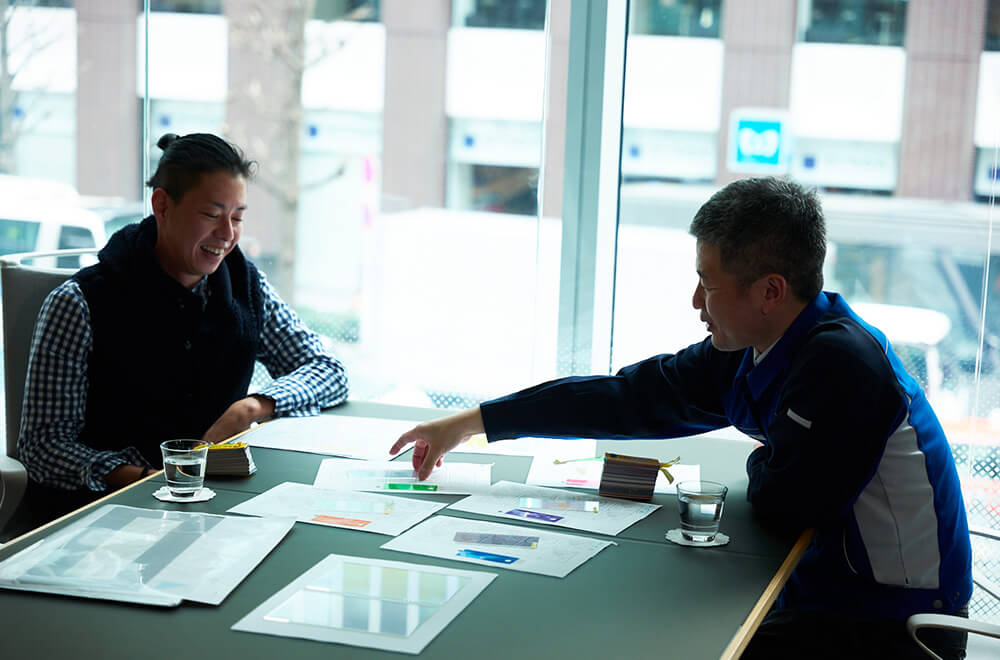
Enyo While Mr. Nakanishi captures color with eyesight, we understand light as a spectrum (numeric values), so if he were to ask us, ‘I want it to be green,” we were unable to respond. If you were to ask me, “I need something with wavelengths between 500 nano and 520 nano”, I could deliver what you want immediately. In our business, we usually manufacture dichroic mirrors that split wavelengths as specified by our customer. For example, for a DNA sequencer, an analytical instrument that contributes to cancer treatment and new drug discovery, a dichroic mirror splits certain wavelengths to detect faint light emitting from the specimen material.
Having said that, however, it is difficult for regular people to specify their desired wavelengths in the way that professionals do. Moreover, what we do is to split light into RGB, whereas in Mr. Nakanishi’s world, color is expressed with CMYK.So, right from the outset, there was no way we could communicate each other (laughs).

Dichroic mirror color samples
Nakanishi I decided that, if I can’t make myself understood, the only thing to do would be to move closer to their way of looking at things, so I ordered in some books and did some study. Of course, it was all very difficult and not of much use, but there is one thing I did understand. That is, the world in which color is expressed with light is completely different from my world, where color is expressed with CMYK.
Color created by light passing through glass is different from the colors of paint, which is what I usually deal with in my daily life, and, depending on the quality, direction, and layers of light in the surroundings, completely different colors are created. These colors can be described as the color in the domain of the gods, created in the course of interaction with nature, and they are not something that humans can easily control. For this reason, for this artwork, I felt as if I was creating it in a world of light, and I have never thought about color in that way.
Enyo I also thought that we might not be able to get anywhere, so I got hold of an over-the-counter color filter and went into the meeting with that as a clue. If we recreate the spectrum by using a spectroscope to measure the color filters that Mr. Nakanishi specified, we would be able to make dichroic mirrors with the same color as the filter. However, that color is the color that shows when light is applied horizontally. Given the characteristics of the material, if the angle of the light being applied changes, the color will change dramatically. I was worried about whether that would really work.
Nakanishi Nevertheless, now that we had some kind of clue, that was at least a step in the right direction. Moreover, Mr. Enyo had made up a color chart to show how the colors look when light is applied in intervals of 10°, so the project finally started to move forward more smoothly.

For this public artwork, about 600 dichroic mirrors of six types, with different sizes and differing penetrating light, were arranged on a massive plate about 6.5 meters long and about 1.5 meters tall. What was it that Nakanishi wanted to express through this artwork?
Nakanishi This artwork is one of series of works that use a technique called “stripe drawing.” My stripe drawings are line drawings that are made up of an infinite number of lines that I draw freehand. With them, I try to express things that float in a space that can be felt with the skin,” such as air flow, humidity, and light, using only the elements of the lines and blank space. I have been using this method for nearly 20 years, but for this particular work, I replaced the lines with glass to pursue a “sculpture of light and color.” With sculpture, you are usually handling tangible materials that you can touch. With this work, however, although you can’t touch it, it is definitely a sculpture that has a shape and a presence and it is a piece that it expresses something that I could only have created with glass.
Enyo From your viewpoint, what is the appeal of glass as a material?
Nakanishi The light that passes through glass, its straight, hard lines, and the beauty of its plains, as well as the sense of tension that can be felt from these elements are its charms, I think. If I had used film, it would have had an impact on its surroundings as a substance, such as bending and swaying in the wind. Glass, on the other hand, has straight lines and does not bend and sway, so as a substance, it has a feeling of being separated from the movement of the wind flowing around it. That’s why glass can be seen more clearly as an image, and its structure of clear layers can be seen more clearly.
Enyo I saw the almost-complete work, and I was very impressed, thinking, “Oh, that’s what happens.” I am quite excited about how it will look once the light angles and other aspects have been finally decided.
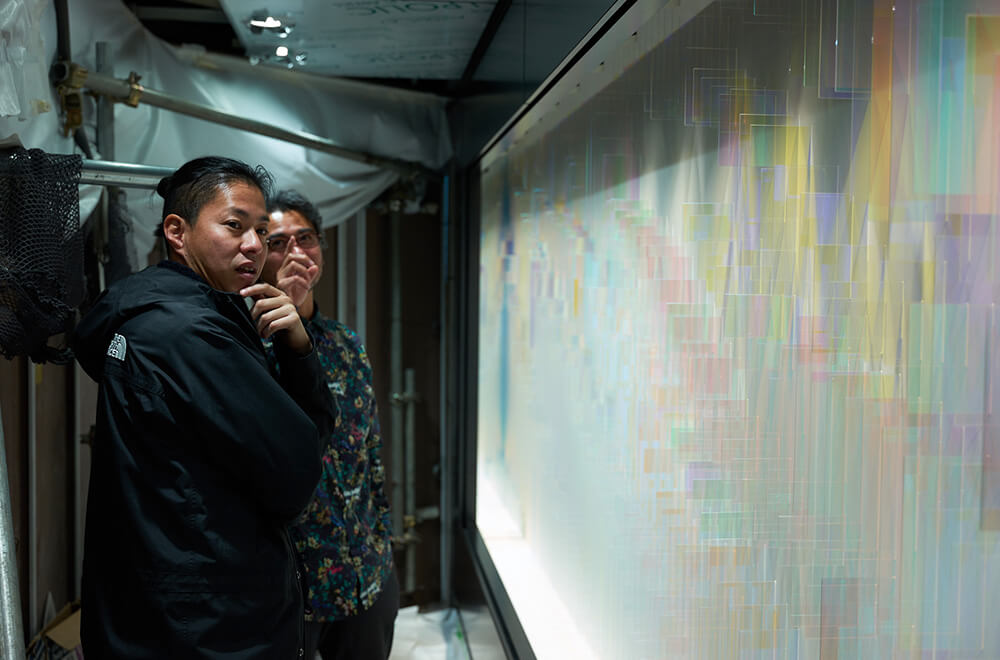
Nakanishi checking the lighting at the installation site
Nakanishi I am actually excited, too (laughs). Once it’s finished and it is what I have been aiming for, the presence of the glass should disappear, and the colors reflected there should stand out as a sculpture in themselves. As a sculptor, I had been thinking about how I should give shape to the material, but this time, I made a point of trying to showcase the characteristics of this material called “dichroic mirror.” The place where this artwork has been installed also faces outside, so the intensity of the light and that way it shows will vary depending on the season and the time of day. The exhibition space is located at a railway station in the center of Tokyo, so many people will pass in front of the work every day. How the work looks will depend on the season, the weather, the humidity, where the people viewing it are standing, and how even their moods on that day. I hope they feel that flow of time through those changes.
As well as Nakanishi and AGC Group, many people are involved in this public art project, including the lighting, design, and installation. As a sculptor who values his own sensibilities and aesthetic above all else, he appears to have gained a great deal from that experience.
Nakanishi The material and the creation process were all new experience for me. I got Mr. Enyo and the many other people involved to teach me what they know, and I have broadened my knowledge every time I talked to them. It has been a very stimulating and valuable experience to me.
Enyo I really enjoyed being involved in Mr. Nakanishi’s artwork. Our products are used in a variety of fields, from medical analysis equipment to a massive telescope in Hawaii, but they are not often visible to people. I hope that, with this artwork as a spark, we can promote our industry as a whole.
Nakanishi I teach at a university, but until now, I have never had the opportunity to teach RGB color principles. To get more people to understand optical films, perhaps we could make a rotating device that casts light at 10° intervals onto the glass that we used in this work. By showing the changes in color in the world of light that you don’t find in paints with a kind of color chart, we might be able to create a “classroom of expression” that links art and science for budding designers and children. This world has an infinite number of colors. I hope to be able to show as many people as possible the beauty and enjoyment to be found in the ways those colors change with their environment.
Optical Coatings Japan, a member of the AGC Group, is using its specialized expertise in optical coatings to demonstrate a distinctive presence in the Group. The adoption of its products for this artwork could be described as an indication of the variety of the AGC Group and its new possibilities.
Public Art Overview
Open date:April 1, 2020
Design/Production:Nobuhiro Nakanishi
Dimensions:Approx. 2.0 m high and approx. 7.0 m wide
Title:Stripe Drawing – Flow of time
Location:Near Exit 3, Kyobashi Station, Tokyo Metro
